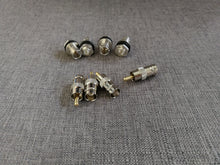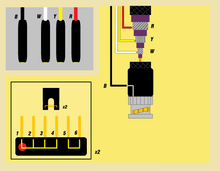Blaxius^2.5 Interlink 75 Ohm (pair)
Regular price
€500.00
Sale
January 31, 2021 : The Blaxius^2 has been replaced by the Blaxius^2.5.
The ^2.5 now has the same shielding configuration possibilities as e.g. the Lush^2 as one of the shields is not required for the ground-return of the cable. See here for the long-winded description : Blaxius^2.5.
The description below has *not* been adjusted to that yet. Thus please see link above. In short : the sound of the Blaxius^2.5 is "no sound at all".
-----------------
The famous Blaxius Interlink, now in ^2 configurable format. For general information and further reference, please look at the Lush^2 page.
General description
The Blaxius^2, although derived from the Lush^2, is electrically very different from the Lush^2 application. While for the Lush^2 it is about the arrangement / configuration of the 3 shields (screens) only, for the Blaxius^2 it is about the combination of shields (screens) and ground.
Each of the shields can be chosen to carry the ground. But, it is just the same allowed to use two shields for that. Or all three of hem. Or connect one at one end but not at the other. Or do that for two. Or ... 225 combinations, really.
As long as there is at least one shield connected from start to end (from A to B connector) there is a legal ground return path. Which of the shields this is (inner, middle or outer) is completely up to you. And what you additionally connect and at which end is also up to you. And mind you, a not connected (at one or at both ends) shield is still shielding. But in a very different way.
Sound
Of course all is about the sound;
The Blaxius in general was created to supply a most robust sound, thinking of how bass should be robust and controlled and such. As a coaxial interlink with the thickest gauge possible for consumer usage (think "connector") sporting 6GHz at a distance of more than 100 meters (3dB down) this worked out for each and everyone obtaining the cable. Bass improves vastly but actually everything improves. It is just that the Blaxius is not able to "filter" because of its ultra high bandwidth (for audio applications - seriously overdone of course).
But the shielding matters even more ...
At Phasure we are new to the Blaxius^2 just the same, but right from the start of listening we already see the jaws dropping everywhere. It is just inordinate what a couple of shielding configurations imply for the sound, knowing that the base cable (the original Blaxius just being in there !) is the very same.
At least for the analogue application it is the most justified what may or may not happen to the signal inside of the cable and how that turns into sound as such at the end of it. This is why the Blaxius^2 theoretically is so much more better for tuning/tweaking than the digital cable the Lush^2 is. And as we know by now, already the Lush^2 influences the sound in unheard fashion, actually at will (of your "config capabilities").
The most prominent is how the upper bass can easily be influenced (and to give an idea : with the Lush^2 this is the mid / upper-mid).
The Blaxius^2 is an end-to-end 75 Ohm impedance cable;
The "BNC" applications for normal Interconnects (like from DAC to (pre-)amp in audio are also mostly 75 Ohm oriented, so the Blaxius^2 is good to go there.
If only RCA connections can be used, then no matter what this is unspecified for impedance, but still the interconnect is allowed to be 75 Ohm and it really won't make it worse. For these situations genuine 75 Ohm RCA to BNC adapters are supplied (one pair per cable) which makes your Blaxius^2 even more versatile than it already is.
Length
You can virtually choose any length you like (see the provided list) but it gets progressively more expensive. This is because of the way the sleeves (also the internal insulation layers) have to be assembled, which goes caterpillar like and requires progressively more and more "caterpillar moves" the longer the cable gets.
Would you like 20 meters or even more ? no worries because the Blaxius^2 will perform the same as if it were 1 meter. But better have some deeper pockets ...
The Blaxius^2, actually requires less length, net, compared to the original Blaxius. This is because the Blaxius^1 virtually weights nothing which makes it "curly float" wherever you want to have it straight. This consumes length. The Blaxius^2 carries so much "self weight" that it presses itself flat/straight.
Also, contrary Blaxius^1, Blaxius^2 allows bending it into a nice radius. You provide the bending and Blaxius^2 itself makes it a smooth bend. This is because of how the sleeve(s) and heir tightness actually guide the bending.
Another nice property of Blaxius^2 compared to Blaxius^1 is that Blaxius^2 is much more forgiving on a too long length. When Blaxius^1 would be 1 meter too long, it would need to go somewhere which probably is right up in the air somewhere, while Blaxius^2 can be laid on the floor like a snake (say left/right/left/right). Just like that. No explicit bending required.
This thus makes it more easy to determine the necessary length for your situation.
Some further physical properties :
Thickness : 19mm
Air dielectric approximately : 8mm (at each side of the main conductor)
Number of screens : 3 (fully configurable for connections at each end)
Insulation layers : between each screen
Weight per 1m per cable : 375gr
Capacitance : 51pF/m
Velocity of propagation (% of speed of light) : 85
Loss over 100m at 10MHz : 1.5dB
Minimum bending diameter from outside to outside : 20cm (radius 10cm)
Required extra length per 90 degree required bend : 10cm
Impedance : 75 Ohm end to end, also when the provided BNC to RCA adapters are used.
Configuration possibilities : 255.
We are maintaining the actual lead time to shipment for new cables : 2 business days.




